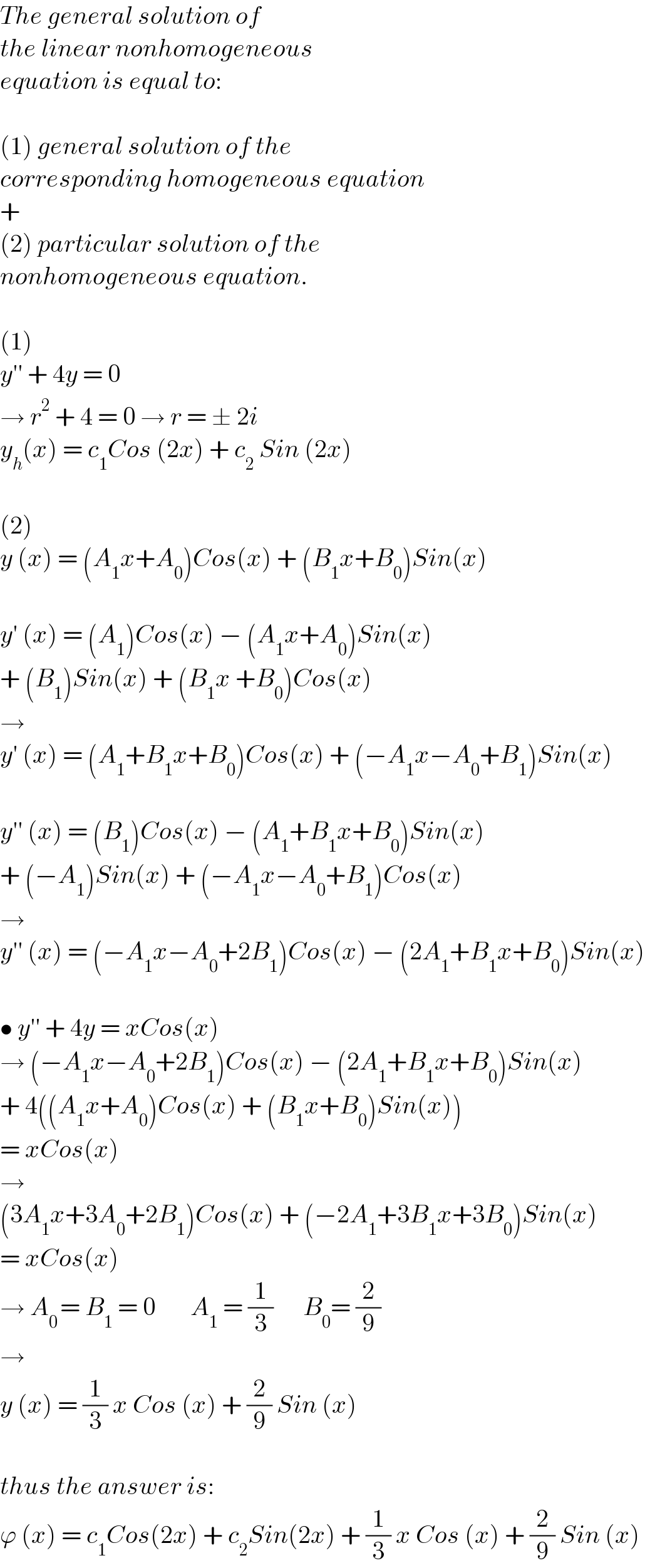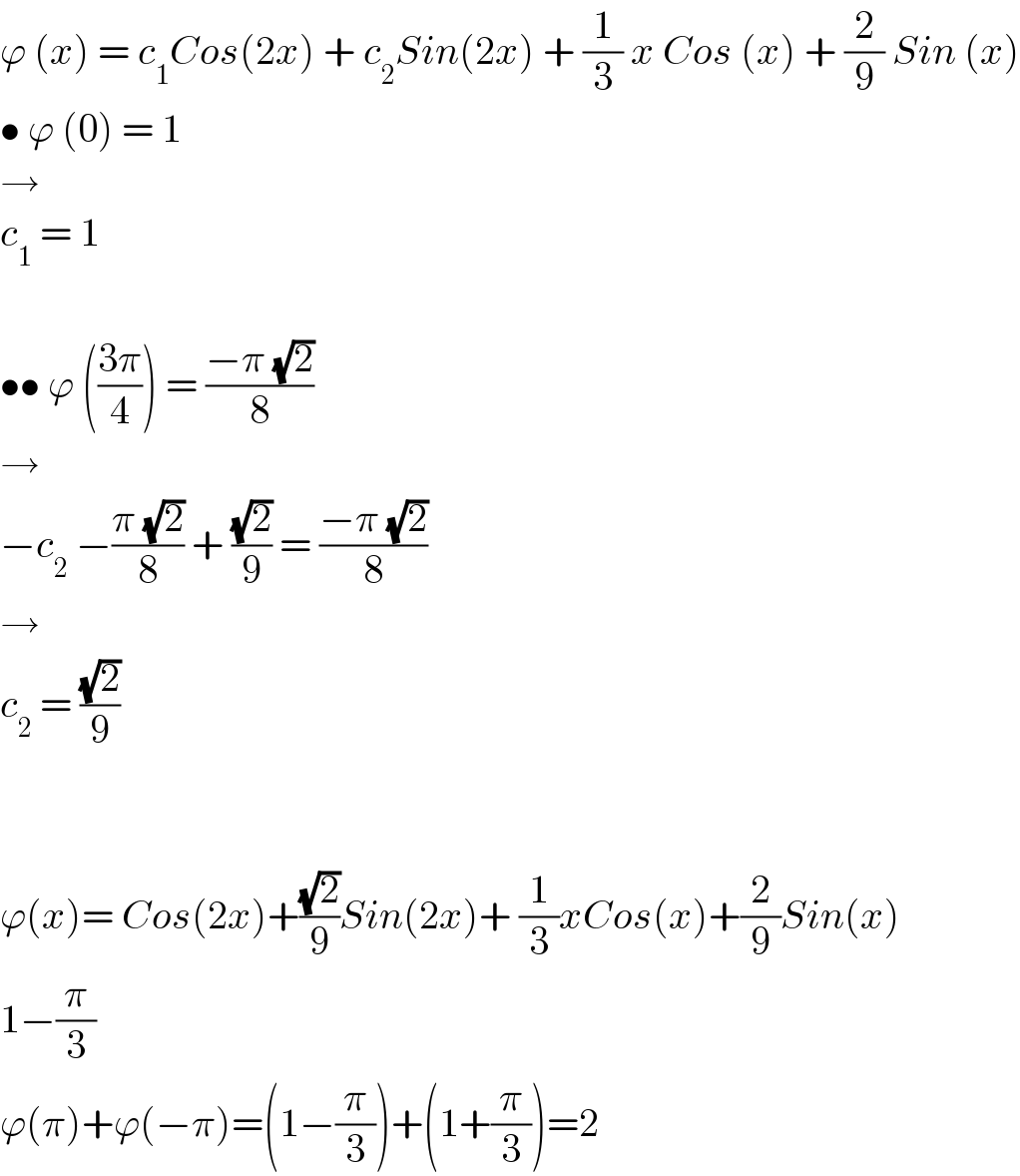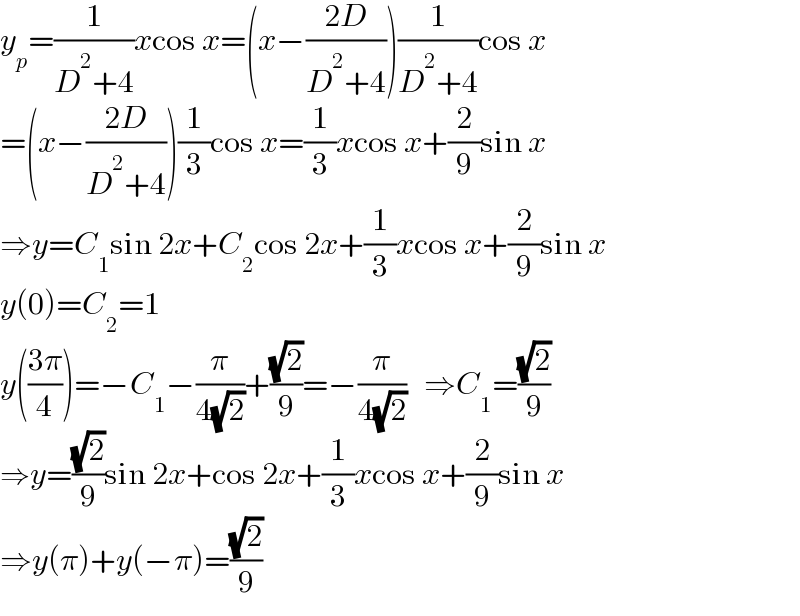Question Number 181858 by KINMATICS last updated on 01/Dec/22

Answered by hmr last updated on 01/Dec/22

$${The}\:{general}\:{solution}\:{of} \\ $$$${the}\:{linear}\:{nonhomogeneous} \\ $$$${equation}\:{is}\:{equal}\:{to}: \\ $$$$ \\ $$$$\left(\mathrm{1}\right)\:{general}\:{solution}\:{of}\:{the} \\ $$$${corresponding}\:{homogeneous}\:{equation} \\ $$$$+ \\ $$$$\left(\mathrm{2}\right)\:{particular}\:{solution}\:{of}\:{the} \\ $$$${nonhomogeneous}\:{equation}. \\ $$$$ \\ $$$$\left(\mathrm{1}\right) \\ $$$${y}''\:+\:\mathrm{4}{y}\:=\:\mathrm{0} \\ $$$$\rightarrow\:{r}^{\mathrm{2}} \:+\:\mathrm{4}\:=\:\mathrm{0}\:\rightarrow\:{r}\:=\:\pm\:\mathrm{2}{i} \\ $$$${y}_{{h}} \left({x}\right)\:=\:{c}_{\mathrm{1}} {Cos}\:\left(\mathrm{2}{x}\right)\:+\:{c}_{\mathrm{2}} \:{Sin}\:\left(\mathrm{2}{x}\right) \\ $$$$ \\ $$$$\left(\mathrm{2}\right) \\ $$$${y}\:\left({x}\right)\:=\:\left({A}_{\mathrm{1}} {x}+{A}_{\mathrm{0}} \right){Cos}\left({x}\right)\:+\:\left({B}_{\mathrm{1}} {x}+{B}_{\mathrm{0}} \right){Sin}\left({x}\right) \\ $$$$ \\ $$$${y}'\:\left({x}\right)\:=\:\left({A}_{\mathrm{1}} \right){Cos}\left({x}\right)\:−\:\left({A}_{\mathrm{1}} {x}+{A}_{\mathrm{0}} \right){Sin}\left({x}\right) \\ $$$$+\:\left({B}_{\mathrm{1}} \right){Sin}\left({x}\right)\:+\:\left({B}_{\mathrm{1}} {x}\:+{B}_{\mathrm{0}} \right){Cos}\left({x}\right) \\ $$$$\rightarrow\: \\ $$$${y}'\:\left({x}\right)\:=\:\left({A}_{\mathrm{1}} +{B}_{\mathrm{1}} {x}+{B}_{\mathrm{0}} \right){Cos}\left({x}\right)\:+\:\left(−{A}_{\mathrm{1}} {x}−{A}_{\mathrm{0}} +{B}_{\mathrm{1}} \right){Sin}\left({x}\right) \\ $$$$ \\ $$$${y}''\:\left({x}\right)\:=\:\left({B}_{\mathrm{1}} \right){Cos}\left({x}\right)\:−\:\left({A}_{\mathrm{1}} +{B}_{\mathrm{1}} {x}+{B}_{\mathrm{0}} \right){Sin}\left({x}\right) \\ $$$$+\:\left(−{A}_{\mathrm{1}} \right){Sin}\left({x}\right)\:+\:\left(−{A}_{\mathrm{1}} {x}−{A}_{\mathrm{0}} +{B}_{\mathrm{1}} \right){Cos}\left({x}\right) \\ $$$$\rightarrow \\ $$$${y}''\:\left({x}\right)\:=\:\left(−{A}_{\mathrm{1}} {x}−{A}_{\mathrm{0}} +\mathrm{2}{B}_{\mathrm{1}} \right){Cos}\left({x}\right)\:−\:\left(\mathrm{2}{A}_{\mathrm{1}} +{B}_{\mathrm{1}} {x}+{B}_{\mathrm{0}} \right){Sin}\left({x}\right) \\ $$$$ \\ $$$$\bullet\:{y}''\:+\:\mathrm{4}{y}\:=\:{xCos}\left({x}\right) \\ $$$$\rightarrow\:\left(−{A}_{\mathrm{1}} {x}−{A}_{\mathrm{0}} +\mathrm{2}{B}_{\mathrm{1}} \right){Cos}\left({x}\right)\:−\:\left(\mathrm{2}{A}_{\mathrm{1}} +{B}_{\mathrm{1}} {x}+{B}_{\mathrm{0}} \right){Sin}\left({x}\right) \\ $$$$+\:\mathrm{4}\left(\left({A}_{\mathrm{1}} {x}+{A}_{\mathrm{0}} \right){Cos}\left({x}\right)\:+\:\left({B}_{\mathrm{1}} {x}+{B}_{\mathrm{0}} \right){Sin}\left({x}\right)\right) \\ $$$$=\:{xCos}\left({x}\right) \\ $$$$\rightarrow \\ $$$$\left(\mathrm{3}{A}_{\mathrm{1}} {x}+\mathrm{3}{A}_{\mathrm{0}} +\mathrm{2}{B}_{\mathrm{1}} \right){Cos}\left({x}\right)\:+\:\left(−\mathrm{2}{A}_{\mathrm{1}} +\mathrm{3}{B}_{\mathrm{1}} {x}+\mathrm{3}{B}_{\mathrm{0}} \right){Sin}\left({x}\right) \\ $$$$=\:{xCos}\left({x}\right) \\ $$$$\rightarrow\:{A}_{\mathrm{0}\:} =\:{B}_{\mathrm{1}} \:=\:\mathrm{0}\:\:\:\:\:\:\:{A}_{\mathrm{1}} \:=\:\frac{\mathrm{1}}{\mathrm{3}}\:\:\:\:\:\:{B}_{\mathrm{0}} =\:\frac{\mathrm{2}}{\mathrm{9}} \\ $$$$\rightarrow \\ $$$${y}\:\left({x}\right)\:=\:\frac{\mathrm{1}}{\mathrm{3}}\:{x}\:{Cos}\:\left({x}\right)\:+\:\frac{\mathrm{2}}{\mathrm{9}}\:{Sin}\:\left({x}\right) \\ $$$$ \\ $$$${thus}\:{the}\:{answer}\:{is}: \\ $$$$\varphi\:\left({x}\right)\:=\:{c}_{\mathrm{1}} {Cos}\left(\mathrm{2}{x}\right)\:+\:{c}_{\mathrm{2}} {Sin}\left(\mathrm{2}{x}\right)\:+\:\frac{\mathrm{1}}{\mathrm{3}}\:{x}\:{Cos}\:\left({x}\right)\:+\:\frac{\mathrm{2}}{\mathrm{9}}\:{Sin}\:\left({x}\right) \\ $$
Commented by hmr last updated on 01/Dec/22

$$\varphi\:\left({x}\right)\:=\:{c}_{\mathrm{1}} {Cos}\left(\mathrm{2}{x}\right)\:+\:{c}_{\mathrm{2}} {Sin}\left(\mathrm{2}{x}\right)\:+\:\frac{\mathrm{1}}{\mathrm{3}}\:{x}\:{Cos}\:\left({x}\right)\:+\:\frac{\mathrm{2}}{\mathrm{9}}\:{Sin}\:\left({x}\right) \\ $$$$\bullet\:\varphi\:\left(\mathrm{0}\right)\:=\:\mathrm{1} \\ $$$$\rightarrow \\ $$$${c}_{\mathrm{1}} \:=\:\mathrm{1} \\ $$$$ \\ $$$$\bullet\bullet\:\varphi\:\left(\frac{\mathrm{3}\pi}{\mathrm{4}}\right)\:=\:\frac{−\pi\:\sqrt{\mathrm{2}}}{\mathrm{8}} \\ $$$$\rightarrow \\ $$$$−{c}_{\mathrm{2}} \:−\frac{\pi\:\sqrt{\mathrm{2}}}{\mathrm{8}}\:+\:\frac{\sqrt{\mathrm{2}}}{\mathrm{9}}\:=\:\frac{−\pi\:\sqrt{\mathrm{2}}}{\mathrm{8}} \\ $$$$\rightarrow \\ $$$${c}_{\mathrm{2}} \:=\:\frac{\sqrt{\mathrm{2}}}{\mathrm{9}} \\ $$$$ \\ $$$$ \\ $$$$\varphi\left({x}\right)=\:{Cos}\left(\mathrm{2}{x}\right)+\frac{\sqrt{\mathrm{2}}}{\mathrm{9}}{Sin}\left(\mathrm{2}{x}\right)+\:\frac{\mathrm{1}}{\mathrm{3}}{xCos}\left({x}\right)+\frac{\mathrm{2}}{\mathrm{9}}{Sin}\left({x}\right) \\ $$$$\mathrm{1}−\frac{\pi}{\mathrm{3}} \\ $$$$\varphi\left(\pi\right)+\varphi\left(−\pi\right)=\left(\mathrm{1}−\frac{\pi}{\mathrm{3}}\right)+\left(\mathrm{1}+\frac{\pi}{\mathrm{3}}\right)=\mathrm{2} \\ $$
Answered by qaz last updated on 01/Dec/22

$${y}_{{p}} =\frac{\mathrm{1}}{{D}^{\mathrm{2}} +\mathrm{4}}{x}\mathrm{cos}\:{x}=\left({x}−\frac{\mathrm{2}{D}}{{D}^{\mathrm{2}} +\mathrm{4}}\right)\frac{\mathrm{1}}{{D}^{\mathrm{2}} +\mathrm{4}}\mathrm{cos}\:{x} \\ $$$$=\left({x}−\frac{\mathrm{2}{D}}{{D}^{\mathrm{2}} +\mathrm{4}}\right)\frac{\mathrm{1}}{\mathrm{3}}\mathrm{cos}\:{x}=\frac{\mathrm{1}}{\mathrm{3}}{x}\mathrm{cos}\:{x}+\frac{\mathrm{2}}{\mathrm{9}}\mathrm{sin}\:{x} \\ $$$$\Rightarrow{y}={C}_{\mathrm{1}} \mathrm{sin}\:\mathrm{2}{x}+{C}_{\mathrm{2}} \mathrm{cos}\:\mathrm{2}{x}+\frac{\mathrm{1}}{\mathrm{3}}{x}\mathrm{cos}\:{x}+\frac{\mathrm{2}}{\mathrm{9}}\mathrm{sin}\:{x} \\ $$$${y}\left(\mathrm{0}\right)={C}_{\mathrm{2}} =\mathrm{1} \\ $$$${y}\left(\frac{\mathrm{3}\pi}{\mathrm{4}}\right)=−{C}_{\mathrm{1}} −\frac{\pi}{\mathrm{4}\sqrt{\mathrm{2}}}+\frac{\sqrt{\mathrm{2}}}{\mathrm{9}}=−\frac{\pi}{\mathrm{4}\sqrt{\mathrm{2}}}\:\:\:\Rightarrow{C}_{\mathrm{1}} =\frac{\sqrt{\mathrm{2}}}{\mathrm{9}} \\ $$$$\Rightarrow{y}=\frac{\sqrt{\mathrm{2}}}{\mathrm{9}}\mathrm{sin}\:\mathrm{2}{x}+\mathrm{cos}\:\mathrm{2}{x}+\frac{\mathrm{1}}{\mathrm{3}}{x}\mathrm{cos}\:{x}+\frac{\mathrm{2}}{\mathrm{9}}\mathrm{sin}\:{x} \\ $$$$\Rightarrow{y}\left(\pi\right)+{y}\left(−\pi\right)=\frac{\sqrt{\mathrm{2}}}{\mathrm{9}} \\ $$
